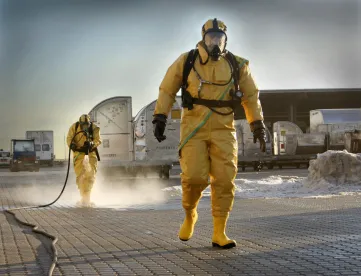On August 30, 2022, the U.S. Chemical Safety and Hazard Investigation Board (“CSB” or the “Agency”) issued a guidance document aimed at helping owners and operators of stationary sources and similar stakeholders understand and comply with CSB’s Accidental Release and Reporting Rule (the “Rule”), finalized by the Agency on February 21, 2020.
The Rule reflects the Agency’s mandate to investigate serious accidents which result from the production, processing, handling or storage of chemical substances and establish requirements for reporting such accidents. The Rule outlines when an owner or operator of a stationary source is required to file a report of an accidental release and the required contents of such a report. The August 2022 Guidance on Reporting of Accidental Releases (“Guidance”) provides and overview of the Rule and offers guiding principles and best practices for owners and operators to determine when an accidental release report must be filed, and what information must be included in the report to meet all established statutory criteria.
Pursuant to the Rule and Guidance, owners and operators must report accidental releases of a regulated substance or other extremely hazardous substance into the ambient air from a stationary source that result in a fatality, serious injury, or substantial property damage. The release of the substance must be “closely associated with the production, processing, handling, or storage of chemicals at a stationary source.” Embedded within these requirements are a number of terms open to the Agency’s interpretation. The Guidance offers the following clarifications regarding what constitutes a reportable “accidental release”:
-
“Accidental release” is an “unanticipated emission”, meaning that the release itself was not intentional. An unanticipated emission resulting from a planned event, such as permitted flaring, still constitutes an “accidental release” if the emission of the substance itself was not planned for or intentional.
-
The term “ambient air” is defined under the Rule as “any portion of the atmosphere inside, adjacent to, or outside a stationary source.” This should be distinguished from EPA’s defining ambient air as the “portion of the atmosphere, external to buildings, to which the general public has access.” CSB declined to adopt this definition because it would undercut the primary purpose of the Agency and its mandate: to protect workers inside structures at a stationary source.
-
The Rule defines “stationary source” as “any buildings, structures, equipment, installations or substance emitting stationary activities (i) which belong to the same industrial group, (ii) which are located on one or more contiguous properties, (iii) which are under the control of the same person (or persons under common control), and (iv) from which an accidental release may occur.” The Guidance clarifies that natural gas transportation facilities, including interstate and intrastate natural gas transmission pipelines, natural gas distribution systems, and natural gas storage facilities incident to transportation, are stationary sources.
-
The term “regulated substance” includes substances that are regulated by the Federal government. CSB points to the list of substances covered by EPA’s Risk Management Plan Rule (see 42 U.S.C. § 7412) or OSHA’s Process Safety Management Standard (see 29 C.F.R. § 1910.119) as examples of regulated substances. Whether a regulated substance involved in an accidental release meets the threshold quantity requirement under other federal regulations is irrelevant.
-
The term “extremely hazardous substance” is defined as any substance which may cause death, serious injury, or substantial property damage. Substances like water or air could be considered extremely hazardous substances if the substance alone, or in combination with other substances or factors, could cause death, serious injury, or substantial property damages. A substance like high-temperature steam could be considered an extremely hazardous substance if these requirements are met, and if the release of high-temperature steam is closely associated with the production, processing, handling, or storage of chemicals at a stationary source.
-
The Guidance clarifies that “regulated substances” or “extremely hazardous substances” include substances in liquid, solid, or gas state. According to CSB, combustible dust could be considered a solid, extremely hazardous substance.
-
Substantial property damage is typically considered damages of over $1,000,000. This figure includes equipment damage, engineering and repair work, loss of use, and damage to natural resources.
On the issue of timing, the Guidance clarifies that the requirement that owners or operators report an accidental release within eight hours has its limits. Commenters expressed concerns to the CSB that facility employees may not be present at a facility to identify the release during the eight-hour window; or that the owner or operator may conclusively find no fatality, serious injury, or substantial property damage has occurred within the eight-hour window, only to receive subsequent information leading to a different conclusion more than eight hours after the release. CSB made clear that in such circumstances the Agency expects owners and operators to act in good faith and immediately report the accidental release upon discovery or receipt of information suggesting it should be reported. Owners and operators have a 30-day “safe harbor” period following the release during which time they must report an accidental release to the Agency if they subsequently received information indicating it was reportable, or update an earlier report with additional information not available during the initial eight-hour window.
The Guidance provides a number of instructive hypotheticals that owners and operators can study to better understand how these guiding principles should be applied in practice. Most importantly, CSB’s Guidance drives home a critical, over-arching message: when in doubt, report. There is no sanction for over-reporting, and CSB estimates that the initial reporting form will take owners and operators less than ten minutes to complete. In contrast, failure to report could lead to an enforcement action brought by EPA. The reporting form can be accessed here.




 />i
/>i

